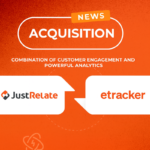Tracking: cookies or data?

by Olaf Brandt
Why should you have to choose between cookies and data for online marketing ? Fortunately, it’s not a question of money or life. At most, however, it is about money. Because without sufficient data, neither store content nor marketing campaigns can be effectively controlled and personalized. And that can cost a lot of money.
The cookie death: first slowly, then suddenly
Ad and browser blocking is increasingly restricting the use of cookies and -like technologies and is slowly thinning out the database. The situation is even more dramatic for many stores, which have to adapt their cookie consent practices following the ruling of the European Court of Justice at the end of 2019 : The ruling confirmed by the highest court that only active consent counts and neither implicit nor forced consent, because cookie banners cannot be closed or refusal is made unnecessarily difficult. The result: only a few users agree and for the marketers the database collapses overnight. Tracking systems run out of and meaningful conclusions about campaign success and user behavior are hardly possible anymore.
It also works without cookies
Ultimately, there is no way around it: marketers must rethink and switch to cookie-free methods. In principle, no cookies are required to reliably record the origin of users, their interactions on the website and conversions. All data generated in individual visit sessions can also be measured without access to the memory of the user device. Only when it comes to customer journeys beyond a time window of 24 hours or targeting on third-party sites do cookies and similar technologies for recognizing users need to be used.
In principle, most analysis solutions can also be used without cookies. However, two criteria should definitely be taken into account when selecting the tool.
1) If the data is also used by the processor for its own purposes or linked to its data, as is the case with Google Analytics, for example, there is a fundamental obligation to obtain consent for data processing – regardless of whether cookies are used or not.
2) Secondly, care should be taken to ensure that cookie-less consent-free tracking is the default setting, so to speak. This way eliminates tedious configuration and additional technical effort.
Three options for cookie-less tracking
If you want to completely dispense with cookie banners and consent dialogs and do not require customer journey tracking, you can fall back on pure cookie-less tracking. If, on the other hand, you set other cookies in the store that require consent, you can take a two-pronged approach: Users who consent to the use of cookies are tracked using cookie-based tracking. All other user interactions, unless they explicitly object to tracking via the privacy policy, are measured without cookies. Shop operators can implement this dual tracking with and without cookies using a single tool . However, it is also possible to use separate solutions for both processes . For example, you do not have to get rid of Google Analytics completely, but can continue to work with it with consent and collect the data that is missing in Google Analytics using a cookie-less web analysis.
Further consequences for remarketing
Legal remarketing or retargeting of store visitors is not available without consent. The German data protection supervisory authorities already made this clear at the beginning of 2019, quite independently of the cookie issue. In line with the motto “Owned Media First”, ‘s own channels are therefore once again gaining importance over ad remarketing. Because the question arises as to what ensures a better advertising effect and higher consent : whether data may be passed on to third parties in order to provide personalized ads or whether users want to be kept up to date via e-mail, web push messages or social media channels?
While subscriptions to newsletters and push services offer real added value for users and online retailers, web analytics and conversion measurement should not be made dependent on consent. The switch to cookie-less tracking must be tackled promptly and set up correctly for a post-cookie era. Then you don’t have to worry about data protection or new browser versions. Cookie crisis resilience is the order of the day in online marketing.
Integration in just a few minutes
In addition to GDPR and cookie consent requirements, the biggest hurdle to high data quality is usually the effort involved in installing and maintaining the tracking tag. To prevent the transfer to etracker from failing, the developers have built in many auto-tracking and trigger operators . This means that the standard tag is usually sufficient. This makes migrating or using it alongside Google Analytics child’s play. The automatic transfer of conversion data to Google Ads also helps .
The EU Commission’s “Digital Omnibus Package” and web analytics: what marketers need to know now


